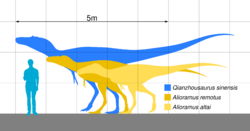Biology:Alioramini
| Alioramins | |
|---|---|

| |
| Holotype skull of Alioramus altai | |
| Scientific classification | |
| Domain: | Eukaryota |
| Kingdom: | Animalia |
| Phylum: | Chordata |
| Clade: | Dinosauria |
| Clade: | Saurischia |
| Clade: | Theropoda |
| Family: | †Tyrannosauridae |
| Subfamily: | †Tyrannosaurinae |
| Tribe: | †Alioramini Olshevsky, 1995 |
| Type species | |
| Alioramus remotus Kurzanov 1976
| |
| Genera | |
Alioramini is a tribe of long-snouted tyrannosaurine tyrannosaurids from the Late Cretaceous epoch. It includes the tyrannosaurid genera Alioramus and Qianzhousaurus. Although tyrannosaurids are known from a variety of places around the globe, alioramins are currently restricted to Asia in mostly Maastrichtian strata.[1]
Alioramins were medium-sized tyrannosaurids, reaching around 5–7 m (16–23 ft) in length.[2][3] Their snouts were much shallower and gracile than other tyrannosaurids, such as the massive Tarbosaurus or Tyrannosaurus. Most notably, their nasal bones were ornamented with a series of rugose, pointy bumps on its top surface.[4]
The tribe Alioramini was first coined in 1995 by George Olshevsky only to contain the at-the-time uncertain Alioramus.[5] In 2014 the tribe was formally defined as a clade-based branch containing all tyrannosaurids more related to Alioramus than to Albertosaurus, Proceratosaurus, and Tyrannosaurus. Hence, the tribe Alioramini consists of three species, namely Alioramus altai, Alioramus remotus, and Qianzhousaurus sinensis.[1]
Alioramins were likely specialized in hunting small-sized prey with quick turns, as indicated by their relative gracile build and long snouts. Such feeding strategy may have avoided direct competition with other tyrannosaurids.[6][7] The characteristic elongated snout morphology of alioramins was likely maintained throughout their ontogeny (growth), as opposed to large/robust tyrannosaurids, whose juveniles underwent drastic skull changes.[7]
See also
References
- ↑ 1.0 1.1 Lü, J.; Yi, L.; Brusatte, S. L.; Yang, L.; Li, H.; Chen, L. (2014). "A new clade of Asian Late Cretaceous long-snouted tyrannosaurids". Nature Communications 5 (3788): 3788. doi:10.1038/ncomms4788. PMID 24807588. Bibcode: 2014NatCo...5.3788L. https://www.nature.com/articles/ncomms4788.pdf.
- ↑ Molina-Pérez, R.; Larramendi, A. (2016). "List of Theropods". Dinosaur Facts and Figures: The Theropods and Other Dinosauriformes. Princeton: Princeton University Press. p. 266. doi:10.1515/9780691190594. ISBN 9788416641154.
- ↑ Xing, L.; Niu, K.; Lockley, M. G.; Klein, H.; Romilo, A.; Scott Persons IV, W.; Brusatte, S. L. (2022). "A probable tyrannosaurid track from the Upper Cretaceous of southern China". Science Bulletin 64 (16): 1136−1139. doi:10.1016/j.scib.2019.06.013. PMID 36659682. https://www.research.ed.ac.uk/en/publications/05d88bb3-8039-426c-88bf-cfb6f08608e7.
- ↑ Brusatte, S. L.; Carr, T. D.; Norell, M. A. (2012). "The osteology of Alioramus, a gracile and long-snouted tyrannosaurid (Dinosauria, Theropoda) from the late Cretaceous of Mongolia". American Museum Novitates (366): 1−197. doi:10.1206/770.1. https://zenodo.org/record/5399269.
- ↑ Olshevsky, G. (1995). "The origin and evolution of the tyrannosaurids, Part 2". Kyoryugaku Saizensen 10: 75–99. https://www.researchgate.net/publication/356879440.
- ↑ Brusatte, S. L.; Carr, T. D.; Erickson, G. M.; Bever, G. S.; Norell, M. A. (2009). "A long-snouted, multihorned tyrannosaurid from the Late Cretaceous of Mongolia". Proceedings of the National Academy of Sciences 106 (41): 17261–17266. doi:10.1073/pnas.0906911106. PMID 19805035.
- ↑ 7.0 7.1 Foster, W.; Brusatte, S. L.; Carr, T. D.; Williamson, T. E.; Yi, L.; Lü, J. (2022). "The cranial anatomy of the long-snouted tyrannosaurid dinosaur Qianzhousaurus sinensis from the Upper Cretaceous of China". Journal of Vertebrate Paleontology 41 (4): e1999251. doi:10.1080/02724634.2021.1999251.
External links
Wikidata ☰ Q17620750 entry
 |


